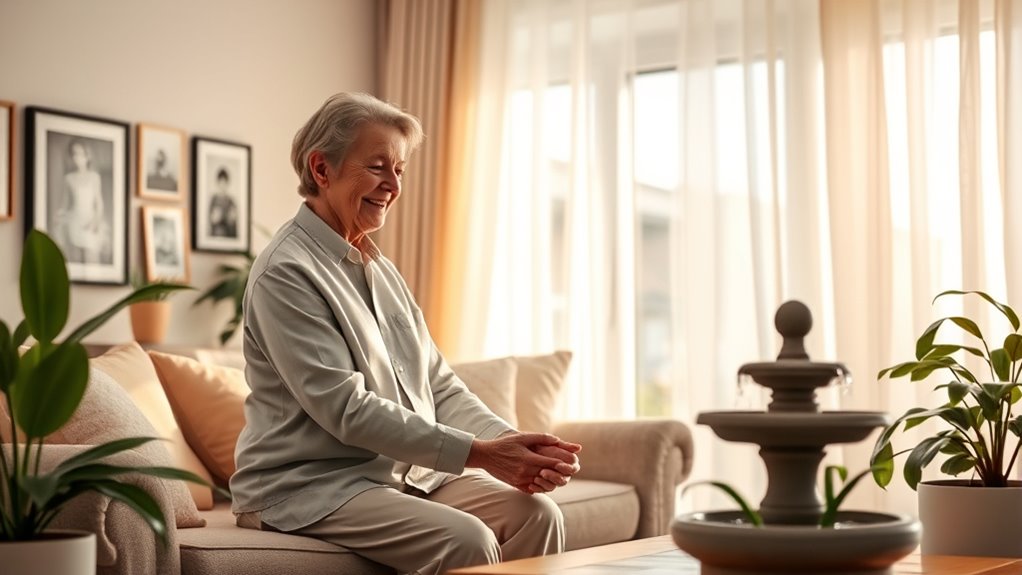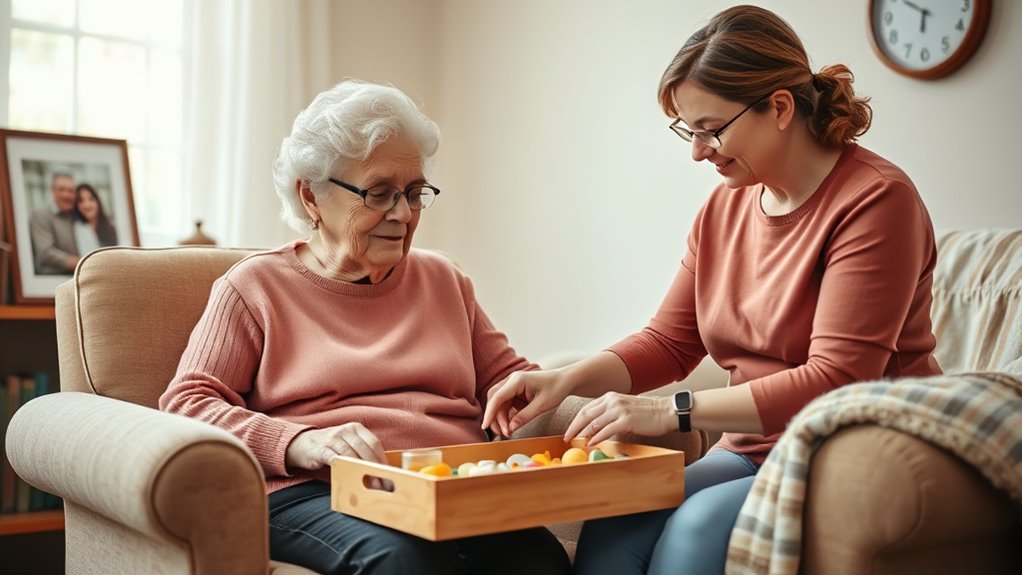To manage agitation in mid-stage Alzheimer’s, identify triggers like physical discomfort or environmental changes. Create a soothing space with simple, familiar objects and soft lighting to promote calm. Use clear, gentle communication and maintain a consistent routine to reduce confusion. Engage in activities like music or sensory stimulation for relaxation. If you want to learn more ways to comfort your loved one and reduce agitation, there are helpful strategies to explore further.
Key Takeaways
- Identify and address triggers like discomfort, environmental changes, or overstimulation to prevent agitation episodes.
- Create a calm, familiar environment with simple decor, soothing lighting, and familiar objects to promote security.
- Use clear, calm communication, and maintain routines to reduce confusion and establish predictability.
- Incorporate non-pharmacological techniques such as music therapy, sensory stimulation, and relaxation to ease agitation.
- Validate emotions, offer reassurance, and engage in familiar activities to build trust and decrease distress.
Recognizing Triggers of Agitation

Understanding what triggers agitation is essential in managing it effectively. You’ll want to observe your loved one closely to identify patterns or specific events that lead to distress. Common triggers include physical discomfort like hunger, thirst, or pain, which they might not be able to express clearly. Changes in routine or environment, loud noises, or unfamiliar surroundings can also cause agitation. Additionally, unmet needs, such as needing to use the bathroom or feeling overstimulated, often play a role. Emotional factors like fear, frustration, or confusion can escalate feelings of agitation. By paying attention to these signs, you can better anticipate when your loved one might become upset and take steps to address these triggers proactively. Recognizing these cues is key to preventing escalation. A higher contrast ratio in visual displays can also help reduce confusion and improve clarity, making it easier for your loved one to process their environment and potentially lowering agitation. Being aware of environmental factors can further aid in creating a calming setting that minimizes triggers.
Creating a Calming Environment

Creating a calming environment plays an essential role in reducing agitation for someone with mid-stage Alzheimer’s. You want the surroundings to promote comfort and safety, minimizing stressors that can trigger agitation. Keep the space simple and clutter-free to prevent confusion. Use soothing colors and soft lighting to create a peaceful atmosphere. Confirm noise levels are low, and avoid sudden or loud sounds that might startle them. Incorporate familiar objects or photos to foster a sense of security. Regularly maintain the environment to prevent hazards and ensure comfort. Utilizing appropriate lighting and color schemes can further enhance a calming atmosphere. Additionally, selecting self watering plant pots can help maintain a low-maintenance yet lively environment, promoting relaxation. Incorporating sensory stimulation techniques can also help engage and soothe individuals when agitation occurs. Implementing environmental modifications based on proven care strategies can significantly improve their well-being and reduce agitation episodes. For example, adjusting the environment to reduce overstimulation can prevent episodes of agitation and help maintain calmness.
Using Communication Techniques Effectively

How you communicate with someone in mid-stage Alzheimer’s can substantially influence their agitation levels. Use simple, clear language and speak calmly to avoid confusion or frustration. Get down to their eye level to make interactions more personal and less intimidating. Be patient if they take longer to respond or seem distracted—don’t rush them. Use non-verbal cues like gentle touch or facial expressions to reinforce your words. Avoid arguing or correcting, as this can increase agitation. Instead, acknowledge their feelings and redirect their attention with a reassuring tone. Keep your voice steady and positive, and give them time to process what you’re saying. Effective communication helps reduce confusion and creates a sense of safety, calming agitation and fostering trust. Additionally, maintaining a consistent routine can provide predictability, helping to lessen anxiety and agitation in individuals with mid-stage Alzheimer’s. Incorporating familiar objects or activities can also serve as calming strategies to soothe agitation.
Implementing Routine and Structure

Establishing a consistent daily routine provides a sense of stability that can considerably reduce agitation in individuals with mid-stage Alzheimer’s. When daily activities follow a predictable pattern, it minimizes confusion and helps your loved one feel more secure. Consistency in meal times, sleep schedules, and activities creates familiarity, reducing anxiety and frustration. To enhance this routine, consider:
- Keeping daily activities simple and familiar
- Using visual cues or reminders for tasks
- Incorporating regular times for rest and relaxation
- Maintaining a calm, quiet environment during progression
- Incorporating familiar routines from anime movies to create comforting associations. Additionally, using structured schedules can help reinforce daily patterns and provide additional reassurance. Consistent routines can also incorporate specialized tools, such as calendars or clocks, to further support orientation and reduce disorientation. Recognizing the importance of medication management can also contribute to overall stability and reduce agitation episodes. Incorporating person-centered care approaches can further tailor routines to individual preferences and needs.
Exploring Non-Pharmacological Interventions

Exploring non-pharmacological interventions offers a compassionate way to manage agitation without medication. These approaches focus on understanding your loved one’s needs and creating calming environments. Activities like music therapy, gentle exercise, and sensory stimulation can reduce restlessness. Validating emotions and providing reassurance help ease distress. Engaging in familiar routines and hobbies fosters a sense of security. Here’s a quick overview:
| Intervention | Benefit |
|---|---|
| Music therapy | Soothes and calms emotionally |
| Aromatherapy | Promotes relaxation and reduces anxiety |
| Reminiscence activities | Enhances mood and cognitive engagement |
| Gentle exercise | Decreases agitation and improves mood |
| Validation techniques | Builds trust and reduces frustration |
These strategies empower you to create a peaceful environment, improving quality of life for both of you.
Frequently Asked Questions
How Can Caregivers Manage Their Own Stress During Agitation Episodes?
When your loved one becomes agitated, it’s natural to feel stressed. To manage your own stress, take deep breaths, step away briefly if you can, and remind yourself to stay calm. Practice self-care by staying connected with friends or support groups, and don’t hesitate to ask for help. Remember, taking care of yourself helps you stay patient and effective in caring for your loved one during challenging moments.
What Legal Considerations Are Involved in Managing Agitation With Medication?
When it comes to managing agitation with medication, you need to keep all your ducks in a row. Legally, you must guarantee proper diagnosis, obtain informed consent, and follow prescribed guidelines. You’ll also need to document medication use and monitor for side effects. Be aware of regulations around involuntary treatment and staying within the scope of practice. Staying informed helps you navigate the legal landscape and provide safe, ethical care.
Are There Cultural Differences Affecting Agitation Management Strategies?
Cultural differences play a significant role in how you approach agitation management. You should consider the person’s cultural background, beliefs, and traditions because these influence their reactions and preferences. For example, some cultures may prefer non-pharmacological methods, while others might be more accepting of medication. By respecting these differences, you can tailor strategies that are respectful and effective, ensuring the individual feels understood and comfortable during care.
How Do Dietary Choices Influence Agitation in Alzheimer’S Patients?
Dietary choices can considerably influence agitation in Alzheimer’s patients. You might notice that a diet high in sugar or processed foods causes spikes in energy and irritability, while balanced meals with whole grains, fruits, and vegetables promote calmer behavior. Proper hydration and avoiding caffeine help prevent mood swings. By paying close attention to what your loved one eats, you can help reduce their agitation and promote overall well-being.
What Are Emerging Technologies for Monitoring Agitation Levels?
Emerging technologies for monitoring agitation blend innovation with compassion. Wearable devices, like smartwatches, track physiological signs such as heart rate and activity levels, alerting caregivers to early signs of distress. Meanwhile, AI-powered cameras analyze movement patterns and facial expressions, providing real-time data. These tools create a seamless connection between technology and care, helping you respond proactively and enhance safety, comfort, and peace of mind for your loved one.
Conclusion
Managing agitation in mid-stage Alzheimer’s can be challenging, but understanding triggers and creating a calming environment make a big difference. Using effective communication and establishing routines help reduce distress. Did you know that non-pharmacological approaches can decrease agitation by up to 70%? By implementing these strategies, you can improve your loved one’s quality of life and maintain a more peaceful daily routine. Stay patient and consistent—you’re making a meaningful difference.









